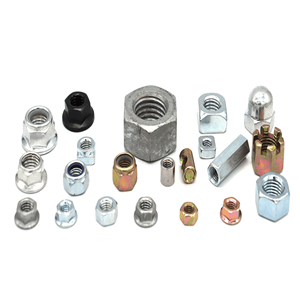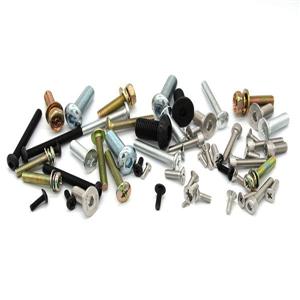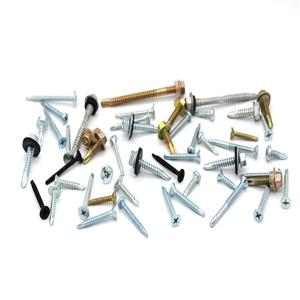Introduction to stainless steel fasteners (2)
Material editor
Stainless steel standard parts have their own requirements for production raw materials. Most stainless steel materials can be made into steel wires or bars for fastener production, including austenitic stainless steel, ferritic stainless steel, martensitic stainless steel, and precipitation hardening stainless steel. So what are the principles when selecting materials? The selection of stainless steel materials is mainly considered from the following aspects:
1. Requirements on the mechanical properties of the fastener materials, especially the strength;
2. The requirements of working conditions on the corrosion resistance of the material;
3. The requirements of the working temperature on the heat resistance (high temperature strength, oxidation resistance) of the material;
4. Requirements on material processing performance in terms of production technology;
5, other aspects, such as weight, price, procurement factors must be considered.
After a comprehensive and comprehensive consideration of these five aspects, the applicable stainless steel materials were finally selected according to relevant national standards. The standard parts and fasteners produced should also meet the technical requirements: bolts, screws and studs (3098.3-2000), nuts (3098.15-2000), set screws (3098.16-2000).
Selection requirementsedit
The requirements for the selection of stainless steel fasteners are mainly stainless steel. Stainless steel is steel that is not easy to rust. In fact, some stainless steels have both stainless and acid resistance (corrosion resistance). The rust and corrosion resistance of stainless steel is due to the formation of a chromium-rich oxide film (passivation film) on its surface. This stainless and corrosion resistance are relative. Tests have shown that the corrosion resistance of steel in weak media such as atmosphere and water and oxidizing media such as nitric acid increases with the increase of chromium water content in steel. When the chromium content reaches a certain percentage, the corrosion resistance of steel occurs Sudden change, from easy to rust to not easy to rust, from not resistant to corrosion. There are many ways to classify stainless steel. According to the organization structure at room temperature, there are martensitic, austenitic, ferritic, and duplex stainless steels. According to the main chemical composition, they can be basically divided into two major systems: chromium stainless steel and chromium nickel stainless steel. There are standard components such as nitric acid-resistant stainless steel, sulfuric acid-resistant stainless steel, and seawater-resistant stainless steel. According to the type of corrosion resistance, they can be divided into pitting resistance stainless steel, stress corrosion resistance stainless steel, and intergranular corrosion resistance stainless steel. For non-magnetic stainless steel, free-cutting stainless steel, low temperature stainless steel, high strength stainless steel and so on. Because stainless steel has a series of characteristics such as excellent corrosion resistance, formability, compatibility, and toughness over a wide temperature range, it has been widely used in heavy industry, light industry, daily necessities, and building decoration industries. .
Austenitic stainless steel
Stainless steel with austenite structure at normal temperature. When steel contains about 18% Cr, Ni 8% ~ 10%, and C about 0.1%. it has a stable austenite structure. Austenitic chromium-nickel stainless steels include the well-known 18Cr-8Ni steels and high Cr-Ni series steels developed by increasing the Cr and Ni content and adding elements such as Mo, Cu, Si, Nb, and Ti. Austenitic stainless steel is non-magnetic and has high toughness and plasticity, but its strength is low. It cannot be strengthened by phase transformation. It can only be strengthened by cold working. If S, Ca, Se, Te and other elements are added, it has good machinability. Stainless steel standard parts In addition to corrosion resistance of oxidizing acid medium, if it contains Mo, Cu and other elements, it can also be resistant to corrosion by sulfuric acid, phosphoric acid, formic acid, acetic acid, urea, etc. If the carbon content in this kind of steel is less than 0.03% or contains Ti and Ni, its intergranular corrosion resistance can be significantly improved. High silicon austenitic stainless steel with concentrated nitric acid has good corrosion resistance. Because austenitic stainless steel has comprehensive and good comprehensive properties, it has been widely used in various industries.
Ferritic stainless steel
Stainless steel with a ferrite structure in the use state. The chromium content is 11% ~ 30%, and it has a body-centered cubic crystal structure. This type of steel generally does not contain nickel, and sometimes contains a small amount of elements such as Mo, Ti, Nb, etc. This type of steel has the characteristics of large thermal conductivity, small expansion coefficient, good oxidation resistance, and excellent stress corrosion resistance. , Water vapor, water and oxidizing acid parts. This kind of steel has the disadvantages of poor plasticity, significantly reduced plasticity after welding and corrosion resistance, which limits its application. The application of external furnace refining technology (AOD or VOD) can greatly reduce the gap elements such as carbon and nitrogen, so stainless steel standard parts have made this kind of steel widely used.




